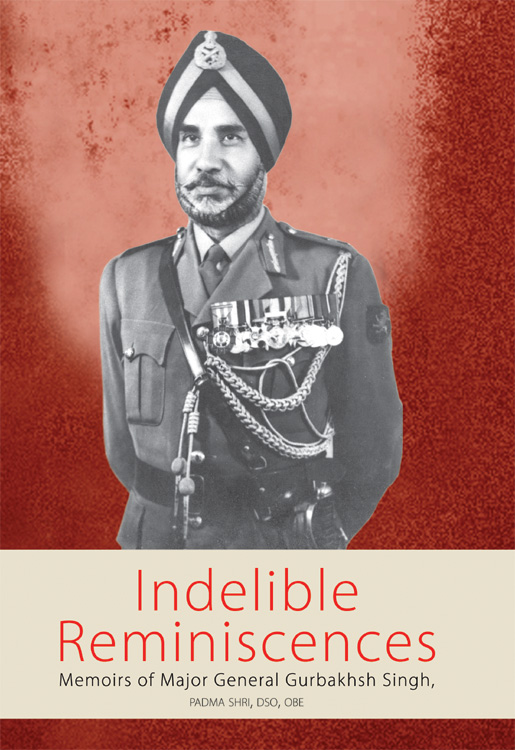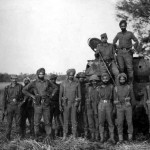To mark the occasion a party was thrown after the meeting. Netaji honoured me by making me sit at his side at the table all the while as long as the party lasted. We returned to our camp in the afternoon where our arrival was being eagerly awaited. Immediately I gave a resume of all that had transpired during our historic meeting with the towering leader of India, to all those officers who were left behind in the camp.
Subhas Chandra Bose, the fire-brand of the Indian Congress, a strong antagonist of the Idealism of non-violence professed and practised by Mahatma Gandhi, escaped from India in January 1941. World War II was in full swing then and the position of the Allies was shaky. Subhas Chandra Bose was expecting nothing spectacular out of the non-violent Satyagraha adopted by the Indian leadership on the advice of Gandhi Ji. He was in prison when he decided to escape out of India to try and turn the critical international situation in India’s favour. He created a grim atmosphere by undertaking a fast unto death in November 1940. He resisted forcible feeding. The Government got alarmed at his determination to die. He was consequently released. He was due to appear in the court for trial on the 26th January 1941. His disappearance became known only when he did not turn up for trial that day.
He grew a beard in Muslim style and disguised as a ‘Mullah’ and escaped through Kabul. Mr. Attar Chand, an Indian in Kabul, helped him further to reach Berlin. It is said that he managed to get a passport issued under an Italian name and flew to Berlin in March 1941. His efforts to start a pro-Indian front in Russia and Germany did not bring any tangible results. He persisted in his efforts and it was almost a year after his escape when the German forces were at the height of their success, the Japanese had captured Burma and had reached the Indo-Burma border, the fate of Moscow and collapse of Russia was taken as certain that he was able to open a ‘Free India Centre’ with the help of Indians settled in Germany and nearby European countries. The first meeting of the ‘Centre’ was held in November 1941 when Subhas Chandra Bose was named as Netaji and the war cry ‘Jai Hind’ for the liberation of India was adopted and ‘Jana Gana Mana’ was chosen as the ‘National Anthem.’
The recruitment of volunteers for the National Army started in the POW camps of the Indian Prisoners in Germany but the response was anything but encouraging. Subsequently, Indian PsOW in Italy and Libya were brought and a National Army of five hundred volunteers were raised from amongst them. The oath-taking ceremony was performed at a ceremonial parade commanded by Lieutenant Colonel Kariappa in September 1942.
The dramatic developments in the East after the arrest of Colonel Niranjan Singh Gill and General Mohan Singh of INA and the dissolution order for the Indian National Army which was issued by the General (recounted later) forced the Japanese to bring Netaji Subhas Chandra Bose from the West to control the situation in the East. Ras Behari Bose, the President of the Indian Independence League did not prove capable enough to steer the Liberation Movement this side.
In February 1943, Netaji Subhas Chandra Bose left Germany in a German Submarine. He was met by a Japanese Submarine and was picked up near Africa. He reached Sumatra and landed from the submarine by a rubber boat on May 4, 1943. From there he flew to Tokyo on May 16, 1943.
After deliberations in Tokyo, Netaji arrived in Singapore on July 2, 1943 where he was given a rousing reception. He took over the President-ship of the Indian Independence League on July 4 and the charge of the Indian Independence Movement in the East. A declaration regarding the formation of Free India Government was made in the presence of Premier H. Tojo, the Prime Minister of Japan, who was on a visit to Singapore those days.
The raising of the Azad Hind Fauj, previously known as the Indian National Army, was announced to the world on May 5, 1943 and took the salute of its Review Parade on May 6, at which Premier Tojo was also present. Subhas Chandra Bose became the Supreme Commander of Azad Hind Fauj and assumed its command directly. General Bhonsle who succeeded Mohan Singh in the INA became the Chief of the Staff. It was three months later on August 28, that I was confronted with Netaji Subhas Chandra Bose, as narrated earlier.
The demise of the INA, prior to its being taken over by Netaji Subhas Chandra Bose, carried many stories.
The one I was told by an INA friend from his first-hand knowledge was that Colonel Niranjan Singh Gill was not happy with his subordinate position to Captain Mohan Singh in the INA. In order to get elected to the ‘Action Committee’ of the IIL which was to be chosen in a forthcoming conference at Bangkok and secure a higher status than Captain Mohan Singh, Colonel Gill wangled to go to Rangoon to carry out an intensive election campaign in his own favour. In spite of his best efforts he failed to get into the action committee of the league. Being disappointed, he planned to contact Army Headquarters in India and to apprise them of his stand in the Indian National Army Movement.
He wrote a letter to the Adjutant General in India and handed its copies to his most loyal and confidant officer emissary, Brigadier Mahabir Dhillon and his trusted Havildar Driver, to be delivered to the Adjutant General. These emissaries were sent with INA patrols to the Indo-Burma border by different routes. The Colonel could do it because he had been deputed and sent to Burma, along with the Intelligence Group of the INA, with the concurrence of the Japanese to collect intelligence regarding Indian Army troops posted on the border. The Brigadier crossed the Border and surrendered himself to the Indian Troops, along with the letter, whereas, the Havildar driver was captured by the Japanese along with a copy of the letter in his custody. The Japanese suspected the Colonel to be a British Agent and started shadowing him.
In the meantime, Colonel Niranjan Singh was reported to have received the ‘Code Word’ (as fixed with his emissary) on All India Radio which instructed him to try to get the INA dissolved.
With a view to achieving this, he came back to Singapore and lodged serious complaints about the bad treatment meted out to the Indians in Burma by the Japanese and also for their non-fulfilment of any of the promises made earlier regarding handing over to the property left behind by Indians to the IIL. He persuaded Mohan Singh not to trust the Japanese and make any further commitment unless a written assurance was forthcoming from the Emperor of Japan, assuring Independence to India, after the war. He knew that such an assurance was not possible. Mohan Singh took a very strong stand in this regard and refused to send the INA troops to Burma for which the ships had already been deployed, unless this assurance was forthcoming.
This stiff attitude adopted by Mohan Singh all of a sudden took the Japanese aback and was attributed not to him but to be the result of arrival and instigation of Colonel Niranjan Singh, whose papers incriminating him of spying had already been received in the Japanese Headquarters. Consequently, Colonel Niranjan Singh was arrested, followed by General Mohan Singh, who refused to listen to any reasoning and disbelieved the story about spying of Colonel Niranjan Singh as given out by the Japanese.
As a result, the dissolution of the INA, as had been planned in case the Japanese failed to give the desired assurance, was affected, but not fully carried out. This happened on December 29, 1942. Later on Colonel Niranjan Singh was said to have committed himself against the British, in an attempt to explain his position in a written petition submitted to the Japanese from the jail. He thus burnt his boats on either side. But this led him to become a national hero after Independence.
(Exactly ten days after the first meeting, Netaji’s summon arrived to meet him). This time I was driven alone to Singapore. General Bhonsle, Chief of the Staff of the INA, received me at Singapore and told me that Netaji had suddenly got busy and thus I would have to stay as guest of the INA till such time he would be free to meet me. I had known General Bhonsle well. At the time of surrender, he had taken shelter with me. He was not liked by the men of his unit and had felt unsafe to live with them. Personal security had prompted him to seek the portals of the INA. His Adjutant, Mr. Sehgal, who later married Lakshmi Bai of ‘Rani of Jhansi Regiment’ fame, was with him at the moment.
I was accommodated with Azad Hind Fauj and hosted by different INA Brigades for a few days in turn, where I was made familiar with their Mess life and other living conditions. I did not have to wait long, before a call came from Netaji. I met him in his office at Singapore. General Bhonsle was also present. Again he asked for my reaction as to whether I was convinced yet and had acquired faith in the Movement. Keeping mum for a while, I told him that to be honest to myself I was not convinced. “Very well,” he said, “You are also doing great service where you are. You are looking after three thousands fellow countrymen.” He took out his cheque book and signed a cheque worth two thousand dollars. Handing me the cheque, he instructed, “Buy fruits etc. and distribute them in your camp on my behalf.” I thanked him, wished him and took leave of him.
Borrowing a truck off General Bhonsle, I went to the Market, bought a load of pineapples and drove back to the camp. I was received by anxious faces. The course of my talks and stay at Singapore was again recounted. It must be said to the great credit of Netaji, that after the Singapore meeting we were not bothered at all and no one ever came to influence or embarrass us anymore.
When a sufficient amount in our ‘Fund’ had been collected, feeling that the money Netaji had given us may not be his personal but part of the National Fund, we felt a desire to send back the amount. Along with a respectful letter, I enclosed the cheque. A loving acknowledgement in Netaji’s own hand was received back as a memorable gift. I treasured this letter till the end. At the time of release from imprisonment, when many crucial papers had to be burnt, it was destroyed. I tore away a piece bearing the final complementary line and signatures of Netaji and my own till today.





